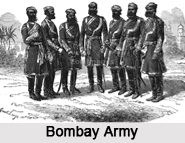 Regiments of Bombay Native Infantry were part of the Bombay Army, which existed during British rule in India. Given below are these Regiments of Bombay Native Infantry.
Regiments of Bombay Native Infantry were part of the Bombay Army, which existed during British rule in India. Given below are these Regiments of Bombay Native Infantry.
1st or Grenadier Regiment of Bombay Native Infantry
1st or Grenadier Regiment of Bombay Native Infantry was created in 1824. After undergoing transformations from 1st Regiment of Bombay Native Infantry (Grenadiers) to 1st Battalion 4th Bombay Grenadiers, the infantry got allocated to India on Partition in 1947.
2nd or Grenadier Regiment of Bombay Native Infantry
2nd or Grenadier Regiment of Bombay Native Infantry was created in 1824. After undergoing transformations from 2nd (Prince of Wales`s Own) Regiment of Bombay Native Infantry to the 2nd Battalion 4th Bombay Grenadiers, the infantry got allocated to India on Partition in 1947.
4th Regiment of Bombay Native Infantry
4th Regiment of Bombay Native Infantry was created in 1824. It became the 3rd Battalion, Brigade of the Guards in 1949.
5th Regiment of Bombay Native Infantry
5th Regiment of Bombay Native Infantry was created in 1824. After undergoing transformations from the 5th Regiment of Bombay Native (Light) Infantry to 2nd Battalion Mahratta Light Infantry, the infantry was allocated to India on Partition in 1947.
6th Regiment of Bombay Native Infantry
6th Regiment of Bombay Native Infantry was created in 1824 and was disbanded in 1882.
7th Regiment of Bombay Native Infantry
7th Regiment of Bombay Native Infantry was a military unit created in 1824. After undergoing transformations from 7th Regiment of Bombay Infantry to The Corps of Bombay Pioneers, the infantry was disbanded in 1933.
8th Regiment of Bombay Native Infantry
8th Regiment of Bombay Native Infantry was created in 1824. After undergoing transformations from 8th Regiment of Bombay Infantry to 3rd Battalion 4th Bombay Grenadiers, the infantry was disbanded in 1930.
9th Regiment of Bombay Native Infantry
9th Regiment of Bombay Native Infantry was a military unit created in1824. It was disbanded in 1930. After undergoing transformations from 9th Regiment of Bombay Infantry to the 4th Battalion 4th Bombay Grenadiers, the infantry was disbanded in 1930.
10th Regiment of Bombay Native Infantry
10th Regiment of Bombay Native (Light) Infantry was created in 1871. It became 10th Regiment of Bombay (Light) Infantry in 1885. After being transformed into 110th Mahratta Light Infantry and 3rd/5th Mahratta Light Infantry, it was allocated to India on Partition in 1947.
Other Regiments of Bombay Native Infantry
Some of the other Bombay Native Infantries were 11th Regiment of Bombay Native Infantry, 12th Regiment of Bombay Native Infantry, 13th Regiment of Bombay Native Infantry, 14th Regiment of Bombay Native Infantry and 15th Regiment of Bombay Native Infantry.



















